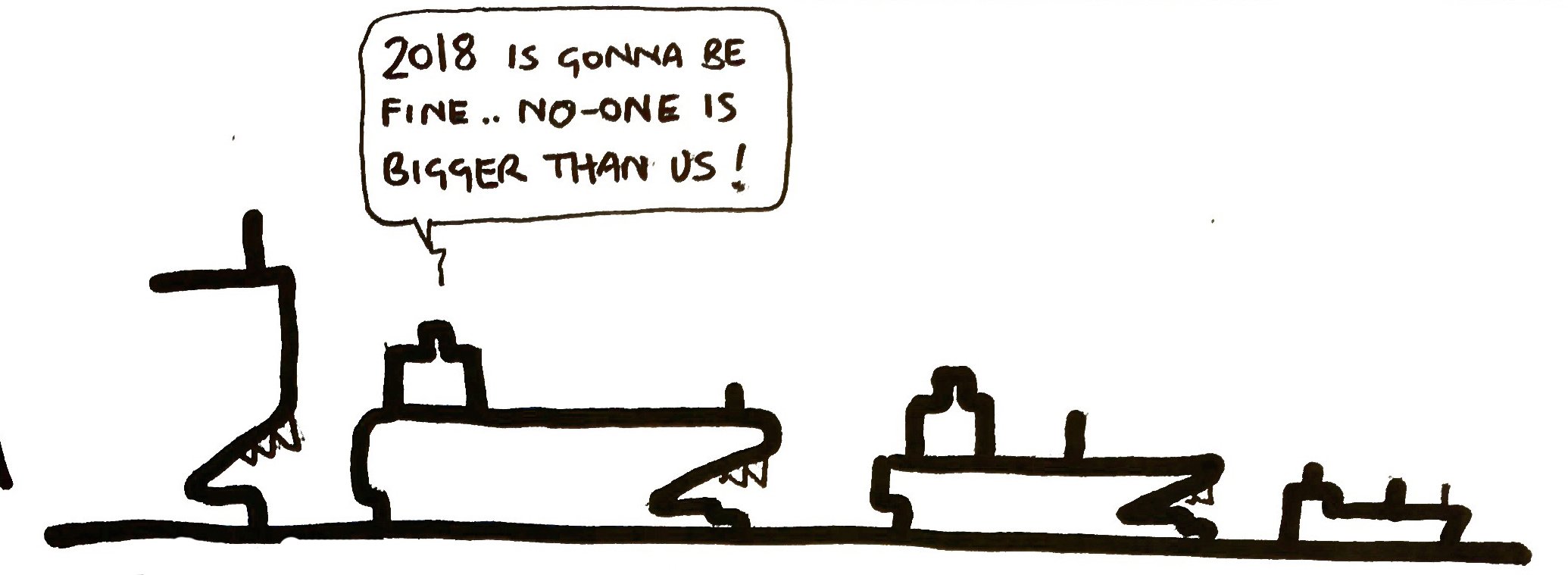Themes that will dominate shipping in 2018

Splash asks top names across the industry for their predictions. Next year is unlikely to be dull for those in maritime.
Such is the volatile nature of shipping that predicting even three months ahead, let alone a full year is nigh on impossible. As a general rule of thumb when it comes to market realities in shipping, if one sector is heavily touted by the majority as a likely winner that often tends to be its kiss of death. Bookies’ favourites in shipping rarely pay out. Fortunately among Splash readers there does not appear to be a clear sector winner as we head into the new year. In an ongoing poll carried on this site LNG has a slim lead over dry bulk in terms of which sector has the best prospects in 2018. Below top names within the industry have dared to stick their neck out and give Splash readers their take on what’s likely to happen in 2018.
Charles De Trenck, one of the world’s most famous shipping analysts, believes dry bulk has better exposure than containers or tankers in the months ahead.
“Containers will be held back somewhat by ship capacity and Cosco subsidies, despite demand being a little better,” De Trenck maintains, adding: “Oil demand in general has been picking up but capacity still seems an issue.”
Warwick Norman, the outgoing CEO at vetting firm RightShip, believes increased demand will see bulk carriers speeding up and the rate of scrapping slowing down.
Mark Williams, managing partner at Affinity Research, is also quietly confident about dry bulk.
“Bulk carrier freight market prospects continue positively as the year winds to its close,” Williams tells Splash. He also touts LNG as a decent bet for the coming 12 months.
However, the Affinity analyst’s main pick for shipowners next year is not sectoral, it’s geographic.
“If you want my top tip for 2018, it’s watch India,” Williams says.
Dr Adam Kent from Maritime Strategies International believes 2018 will see “modest” improvements in earnings for most sectors, but remains concerned about the looming prospect of a bumper round of orders at Asian shipyards.
“Although by the end of 2018 most shipping sectors will see earnings improve on their end 2017 equivalents gains will, in large, be modest,” Kent predicts.
“The eternal worry as we enter 2018,” Kent continues, “is that that the triple impact of the positive momentum in earnings however small, desperate shipyards offering low newbuilding prices and a swirl of optimistic sentiment, will drive owners to order vessels in their droves.” This has the potential yet again to stop, “dead in its tracks”, any sustained recovery almost regardless of what happens the demand side, Kent warns.
Kent’s caution is echoed by Panos Patsadas from brokers Target Maritime Transport.
“The first check point for dry bulk is around the corner,” Patsadas reckons, explaining that the time between year-end and Chinese New Year will indicate if there is substance behind the hype, and if the Baltic Dry Index has raised its floor to breakeven levels.
Patsadas has some other bold dry bulk predictions. 2018 will signal the end of the panamax segment in the dry market, he believes, becoming obsolete to both ultramaxes and kamsarmaxes.
In terms of the sector that excites him most however Patsadas pins his colours to the smaller boxship segment.
“I can’t help but notice the underlying value certain players hint in the container market and the sub panamax segment,” the Greek broker says, elaborating: “Bold buying sprees by MPC, Navios planning a listing with a separate container entity, as well as more quiet players such as Lomar investing heavily in the segment, suggests there is something there.”
Bjorn Hojgaard, CEO of Anglo-Eastern Univan Group, has some simple advice for Splash readers going into 2018.
“Hope for the best but prepare for the worst,” says the shipmanager.
On a macro level, the big question for Hojgaard is whether the simultaneous economic upswing in US, Europe, China and to some extent Japan in the second half of 2017 is sustainable and will continue into 2018, or if one of the many macro risks on the horizon might derail the growth and through that deflate the hopes for better rates in shipping in the year ahead.
Another factor to be aware of as the new year approaches is the impact legislators could have on earnings, something MSI’s Kent is all too aware of, telling Splash: “Policy and regulations will continue to shape the shipping markets in 2018, with the binary nature of decision makers able to dislocate market fundamentals and impact vessel profitability.”
Incoming legislation is something that Simon Doughty, CEO of Hong Kong’s Wallem Group, also picks out as a key thing for shipowners to be aware of in the coming months and years.
“There will be a number of regulations coming into force in the next couple of years – regarding key issues such as emissions, ship operations and pollution liability and we will need to prepare for these,” Doughty tells Splash. “This means learning from best practices and adapting processes accordingly. It also means training to ensure that everyone involved, both on shore and at sea is well aware of both the latest requirements and their responsibilities in order to maintain a quality reliable service. Given that management fees have not changed in a decade while other costs continue to rise, the cost of compliance to these new regulations will be a big challenge for third party ship managers.”
When it comes to the topic of legislation, and specifically the environment, a source of many Splash headlines this year, RightShip’s Norman is not confident shipping will be ready for the 2020 sulphur ban, and he is unsure if the industry can hash out a suitable deal on greenhouse gas (GHG) emissions on its own.
“Progress on GHG emissions will be slow at IMO HQ but market forces will increase pressure and continue to take action,” Norman predicts.
Frank Coles, CEO of equipment manufacturer Transas, and one of shipping’s most vocal proponents on the industry’s likely digital transformation, picks out three trends that will dominate maritime headlines next year.
“The delineation between shipping and maritime will become more defined,” Coles predicts. “Those companies who ship cargo/goods (charterers) will make more decisions, acquisitions operational changes in terms of efficiency and digitalisation. The maritime carriers/owners will be faced with the growing realisation that papering over the cracks of the current model is not going to be enough.”
After the hype of 2017 and unmanned dream mania, Coles believes we are going to see the introduction of solutions to begin the transition to a new ecosystem of smart solutions that provide improved decision support for the maritime operations world. This will provide enhanced decision support for the human element, Coles thinks, and greater ship to shore interaction and combined operations.
Coles, a speaker at the Maritime CEO Forum’s Future of Shipping panel earlier this year, also believes increased consolidation in the market vendor market is on the cards in 2018, especially among communications and equipment suppliers.
“Products like airtime and much of the bridge equipment are now commodities. The new digitalised world will be a standardised environment and the need for multiple vendors will be less relevant,” Coles says.

Like our cartoonist The Freaky Wave, Harry Theochari, global head of transport at law firm Norton Rose Fulbright, believes consolidation – a key theme in 2017 – will continue a pace next year.
“Consolidation is becoming a key feature for both the shipping and aviation industry with mergers and acquisitions likely to continue into 2018. China is very likely to continue to drive some of the most exciting and innovative transactions including sale and leaseback deals structured on both pure equity and equity/debt structures, with debt provided by Chinese, other Asian and a decreasing number of European banks,” Theochari predicts.
The mood then as desks are cleared for the last working day of 2017 appears to be one of cautious optimism among the world’s shipowners. Nevertheless, owners would be advised to heed the final wise words of this 2018 feature from Christoph Toepfer, the head of the fast growing London headquartered owner Borealis Maritime. “When too many are optimistic for a good year to come, remain watchful!” Toepfer warns.
To read Splash’s take on the highs and lows of shipping in 2017, click here.
